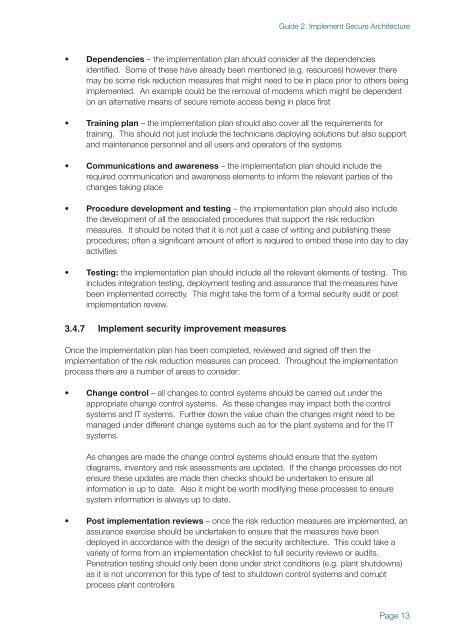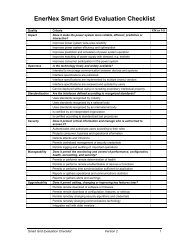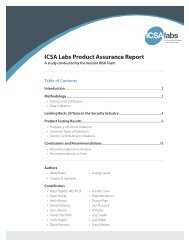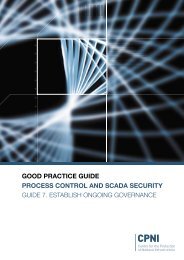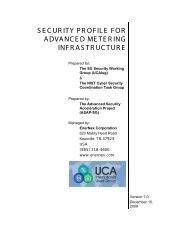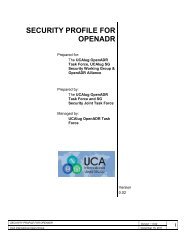CPNI - GPG - Guide 2 - Implement Secure Architecture
CPNI - GPG - Guide 2 - Implement Secure Architecture
CPNI - GPG - Guide 2 - Implement Secure Architecture
You also want an ePaper? Increase the reach of your titles
YUMPU automatically turns print PDFs into web optimized ePapers that Google loves.
<strong>Guide</strong> 2. <strong>Implement</strong> <strong>Secure</strong> <strong>Architecture</strong><br />
• Dependencies – the implementation plan should consider all the dependencies<br />
identified. Some of these have already been mentioned (e.g. resources) however there<br />
may be some risk reduction measures that might need to be in place prior to others being<br />
implemented. An example could be the removal of modems which might be dependent<br />
on an alternative means of secure remote access being in place first<br />
• Training plan – the implementation plan should also cover all the requirements for<br />
training. This should not just include the technicians deploying solutions but also support<br />
and maintenance personnel and all users and operators of the systems<br />
• Communications and awareness – the implementation plan should include the<br />
required communication and awareness elements to inform the relevant parties of the<br />
changes taking place<br />
• Procedure development and testing – the implementation plan should also include<br />
the development of all the associated procedures that support the risk reduction<br />
measures. It should be noted that it is not just a case of writing and publishing these<br />
procedures; often a significant amount of effort is required to embed these into day to day<br />
activities<br />
• Testing: the implementation plan should include all the relevant elements of testing. This<br />
includes integration testing, deployment testing and assurance that the measures have<br />
been implemented correctly. This might take the form of a formal security audit or post<br />
implementation review.<br />
3.4.7 <strong>Implement</strong> security improvement measures<br />
Once the implementation plan has been completed, reviewed and signed off then the<br />
implementation of the risk reduction measures can proceed. Throughout the implementation<br />
process there are a number of areas to consider:<br />
• Change control – all changes to control systems should be carried out under the<br />
appropriate change control systems. As these changes may impact both the control<br />
systems and IT systems. Further down the value chain the changes might need to be<br />
managed under different change systems such as for the plant systems and for the IT<br />
systems.<br />
As changes are made the change control systems should ensure that the system<br />
diagrams, inventory and risk assessments are updated. If the change processes do not<br />
ensure these updates are made then checks should be undertaken to ensure all<br />
information is up to date. Also it might be worth modifying these processes to ensure<br />
system information is always up to date.<br />
• Post implementation reviews – once the risk reduction measures are implemented, an<br />
assurance exercise should be undertaken to ensure that the measures have been<br />
deployed in accordance with the design of the security architecture. This could take a<br />
variety of forms from an implementation checklist to full security reviews or audits.<br />
Penetration testing should only been done under strict conditions (e.g. plant shutdowns)<br />
as it is not uncommon for this type of test to shutdown control systems and corrupt<br />
process plant controllers<br />
Page 13


